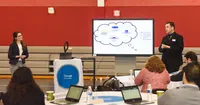Using technology to empower students and turn them into critical thinkers

Editor’s note: Google for Education Premier Partners are working with schools to host the ExploreEDU event series, where schools can share their first-hand experiences with other educators. Today’s guest author is Kyle Black, a high school English teacher from First Philadelphia Preparatory Charter School, which hosted an ExploreEDU event on March 21-22 with Promevo. To see if there’s an event near you, visit the ExploreEDU site.
In a world dominated by technology, a good education depends on digital know-how—in addition to problem solving, clear communication and organizational skills. Students need both digital and soft skills to guide them through college, into the workplace and beyond.
In my five years on the job, here’s what I’ve learned about teaching a generation of students to use technology in responsible and impactful ways:

1. Empower students to take control of their learning
High school students are learning how to work independently and use technology to explore new concepts. When AP English students come across a word they don’t know in Shakespeare’s “King Lear,” for example, they can look it up on their Chromebooks rather than ask me for the definition. Students love proving me wrong about facts related to classic literature like “The Crucible” by researching on their Chromebooks—and their eyes light up when their point of view is validated. With classroom technology, we’re teaching students to take charge of their own learning and engage in healthy debate.2. Quiz students often to assess understanding
Every day my students take mini-quizzes via Google Forms so I can gauge whether they understand the topic I just covered or if I need to modify my instruction. When teaching semicolons, for instance, my students take a four-question quiz using their Chromebooks to identify sentences that use semicolons correctly. If 75 percent of the class gets a question wrong, I know to back up and explain the concept in a different way or provide more examples. This not only improves their academic performance, but it also it teaches them the importance of clear communication and continuous feedback.
3. Turn feedback into a critical thinking exercise
It’s common for students to accept a teacher’s revisions to their work without considering why specific changes are made. By making the feedback process interactive, students are encouraged to think critically before accepting edits at face value. For example, when I’m reviewing essays or creative writing, I often suggest incorrect or ridiculous changes using comments and suggested edits in Google Docs—and my students know this type of feedback is coming. Typically, half of my edits will require students to think deeply before hitting the “accept” button. It forces them to play a more active role in their learning, and to constantly challenge ideas.
I believe that teaching students digital and critical thinking skills matters more than teaching them how to ace a test. To prepare students for lifelong success, we must encourage them to brainstorm new ideas and embrace the new tools at their fingertips.






